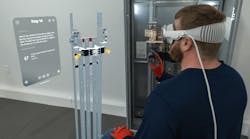The BICSI 2005 Spring Conference, held at the Mirage Resort and Convention Center in Las Vegas May 2-5, drew more than 3,200 attendees who wanted to learn about the new markets and services that deliver information for audio, data, video or voice circuits over a common physical network.
These networks have developed into a niche of the voice/data/video (VDV) business now called the information transport (ITS) industry. BICSI's interests in this market segment are so strong that the Tampa-based trade association developed a new logo with a tagline that says, “Advancing information transport systems” to affirm its support of the ITS industry.
Conference seminars covered the integration of business information systems and building automation systems, the basics of video surveillance systems (CCTV), new developments in local area network (LAN) cabling, the National Electrical Code (NEC) regulation calling for the removal of abandoned communications cable, optical fiber cable and connectors for premise applications and installing wireless LAN systems.
Technologies that received much of the attention on the exhibit floor and in seminars were wireless communications, radio frequency identification (RFID), high-performance copper cabling, indoor/outdoor fiber-optic cable, Voice over Internet Protocol (VoIP) and industrial Ethernet cabling.
Wireless communications will bring a host of services to mobile users. Cell phones, wireless LANs, wireless home networks and Wi-Fi sites allow voice and data communications to take place without any location restrictions.
Wi-Max
The most intriguing aspect of wireless communications is probably Wi-Fi, and its next generation: Wi-Max. Wi-Max is projected to offer faster speeds and a much greater range. It's expected to deliver data speeds of 70Mbps or more over distances of more than 37 miles. This technology could provide broad geographic areas with true wireless broadband service. Although the faster data speeds of Wi-Max attract attention, more important is its greater range. Much like cellular service, Wi-Max signals can blanket specific neighborhoods or an entire city.
In one example of this technology, business and residents in Rio Rancho, N.M., can get high-speed telephone and Internet access through a Wi-Max network. According to the network's developer, Azulstar New Mexico, Rio Rancho, the city-wide network is the world's largest voice, data and video Wi-Max network. The company says 200 Wi-Fi access points provide a seamless “cellular” Wi-Fi cloud across the city. The system went live this year.
Back on the ground in building applications, an extensive wired network is always needed to support any Wi-Fi wireless communications network. In fact, connecting one user to a wireless system requires just about as much cable and cable management as a completely hard-wired LAN. The only segment that is actually “wireless” is the space, or distance, between the access point — which is usually installed in the ceiling and wired back to the telecommunications closet — and the phone, computer, printer or other device being served.
Voice over Internet Protocol (VoIP)
Business class VoIP services combine local and long-distance voice with e-mail, voice mail, instant messaging, audio conferencing, Web-based conferencing and fax capabilities. All of these services can be integrated onto a desktop computer, or wherever someone has access to the Internet.
Encryption makes VoIP even more secure than analog telephone circuits. On the down side, VoIP doesn't yet provide the reliability and quality of conventional telephone service.
Power over Ethernet (PoE)
Additionally, a method of providing power to IP-based telephones that is growing in importance is Power over Ethernet (PoE). The IEEE 802.3af Task Force has ratified this technology, which allows the delivery of power over Category 5, 5e, patch cables patch panels and connecting hardware. It is endorsed by vendors of power IP-connected devices, such as wireless LAN (WLAN) access points (AP), and security products.








